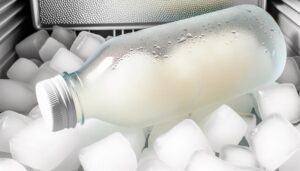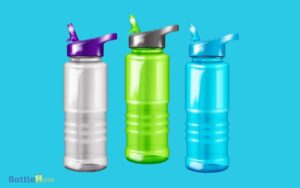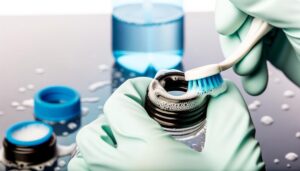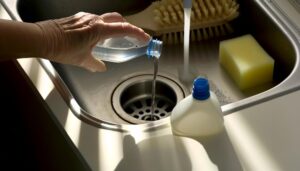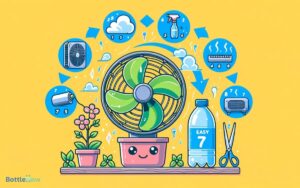Can a Dog Drink From a Rabbit Water Bottle? Yes
Yes, your dog can technically drink from a rabbit water bottle, but it’s generally not recommended. Rabbit water bottles are designed for smaller animals with different drinking techniques and have smaller nozzles that can impede a dog’s water intake.
Dogs need a more significant water flow and prefer to lap from a bowl, which suits their hydration requirements better. Using a rabbit water bottle could lead to frustration and potential dehydration for your dog, especially larger breeds.
If you’re looking for hydration solutions that are more suitable for dogs, there are better options available for you to explore.
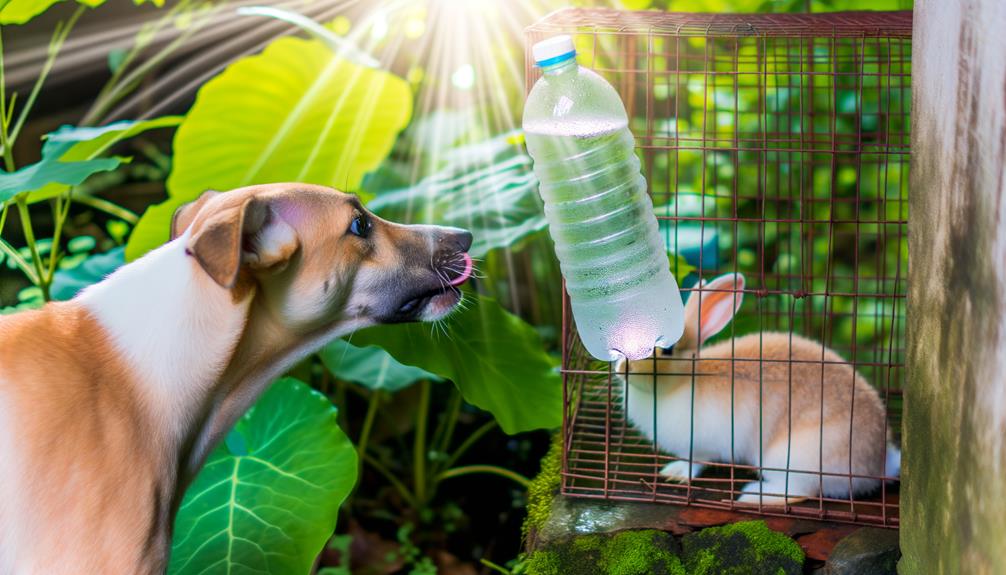
Key Takeaways
- Dogs can technically drink from a rabbit water bottle, but it may not meet their hydration needs due to limited water flow.
- Rabbit water bottles have smaller nozzles that may frustrate dogs, especially larger breeds, leading to possible dehydration.
- Dogs prefer lapping water, and rabbit water bottles may not accommodate this natural behavior effectively.
- Rabbit water bottles require frequent cleaning to prevent bacterial growth, which may be impractical for dog owners.
Understanding Rabbit Water Bottles
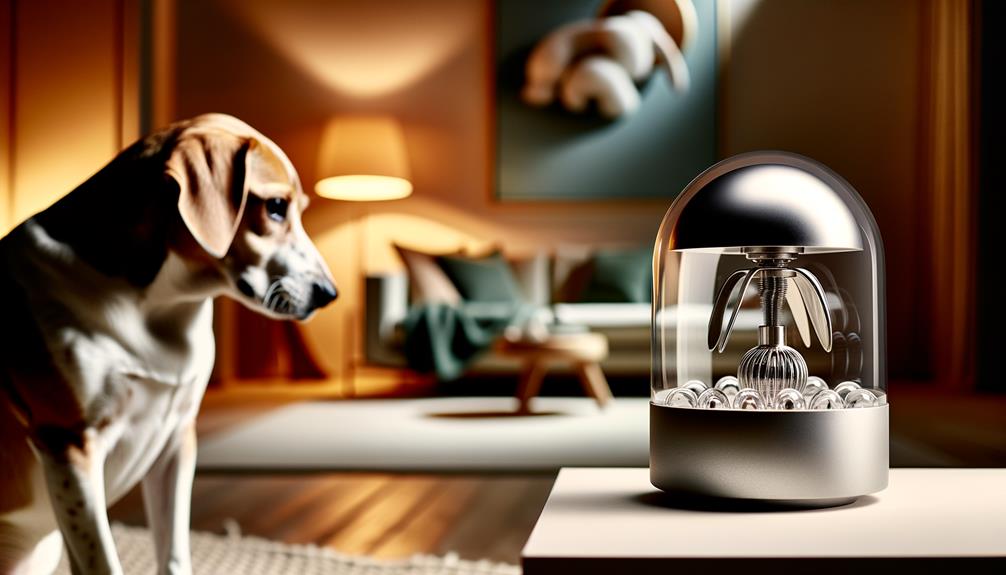
Rabbit water bottles, often called sipper bottles, are designed to deliver a steady supply of water through a gravity-fed system. This system guarantees that water is available whenever your rabbit needs it, minimizing contamination and waste.
Sipper bottles typically feature a metal tube with a ball bearing that controls the flow of water, allowing only a small amount to be released with each lick. This design is highly effective for small animals, as it keeps their environment dry and reduces the risk of bacterial growth.
It’s essential to regularly clean and refill these bottles to maintain ideal hydration and prevent any potential health issues. Understanding how these bottles function helps you provide the best care for your rabbit’s hydration needs.
Differences Between Dog and Rabbit Hydration
Dogs and rabbits have markedly different hydration needs due to their distinct physiological and behavioral traits. Dogs generally require more water daily, about 1 ounce per pound of body weight, while rabbits need around 50-150 ml per kg. This is due to differences in activity levels, metabolic rates, and dietary moisture content.
| Metric | Dogs | Rabbits |
|---|---|---|
| Daily Water Intake | 1 oz per lb | 50-150 ml per kg |
| Hydration Method | Bowl | Bottle or bowl |
| Activity Level | High | Moderate to low |
| Dietary Moisture | Varies (dry or wet food) | High (fresh greens) |
Understanding these differences helps guarantee each pet stays properly hydrated, promoting overall health and well-being.
Bottle Size and Capacity
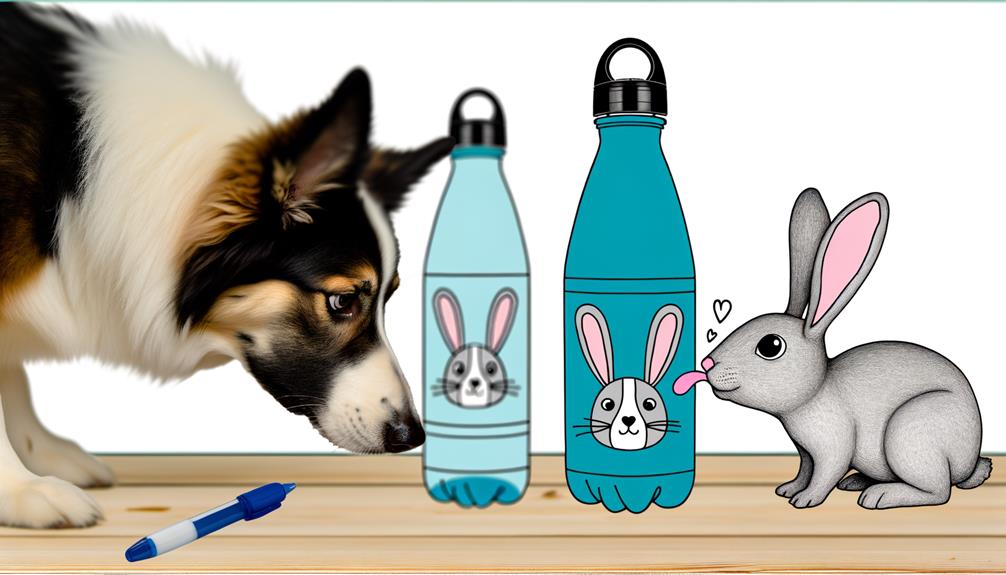
When considering bottle size and capacity, you need to guarantee the water volume is adequate for your dog’s daily intake.
Rabbit water bottles often hold less water and may not meet a dog’s hydration needs.
Additionally, the nozzle size must be compatible with your dog’s mouth to allow for efficient drinking without causing frustration or discomfort.
Appropriate Water Volume
Selecting the correct water bottle size and capacity is vital to guarantee your dog stays adequately hydrated throughout the day.
Research indicates that dogs need approximately one ounce of water per pound of body weight daily. As a result, a 50-pound dog requires around 50 ounces of water.
Rabbit water bottles typically range from 16 to 32 ounces, which may not suffice for larger dogs. Additionally, frequent refilling can be inconvenient and may lead to inconsistent hydration.
Opt for larger bottles designed specifically for dogs, ensuring they align with your pet’s daily water needs.
Monitoring water intake is essential; inadequate hydration can lead to health issues such as urinary tract infections and kidney problems.
Always prioritize your dog’s hydration requirements for peak health.
Nozzle Size Compatibility
While larger bottles are necessary for guaranteeing adequate hydration, the nozzle size also plays a critical role in determining whether a rabbit water bottle is suitable for your dog.
Dogs have different drinking mechanics compared to rabbits, so you need to guarantee the nozzle allows sufficient water flow. Evidence shows that smaller nozzles, typically designed for rabbits, can impede a dog’s ability to drink efficiently, leading to potential dehydration.
A larger nozzle is generally better suited for dogs as it accommodates their broader tongues and stronger suction. Clinically, a nozzle diameter of at least 10mm is recommended for small to medium-sized dogs.
Always monitor your dog’s drinking to guarantee they’re getting the water they need efficiently and comfortably.
Material Safety for Dogs
Guaranteeing material safety for dogs involves scrutinizing the components of rabbit water bottles to confirm they’re free from harmful chemicals and toxins.
You’ll need to check if the bottle is BPA-free and made from food-grade plastics or stainless steel. Harmful substances like phthalates and lead can pose significant health risks.
Veterinary toxicologists recommend avoiding bottles with unknown materials, as these could leach dangerous chemicals into your dog’s water. Additionally, inspect if the bottle material can withstand chewing, as some dogs may attempt to gnaw on it.
Always look for products that have been tested and certified by reputable organizations. By doing so, you guarantee your dog’s hydration source is both safe and reliable.
Ease of Use for Dogs
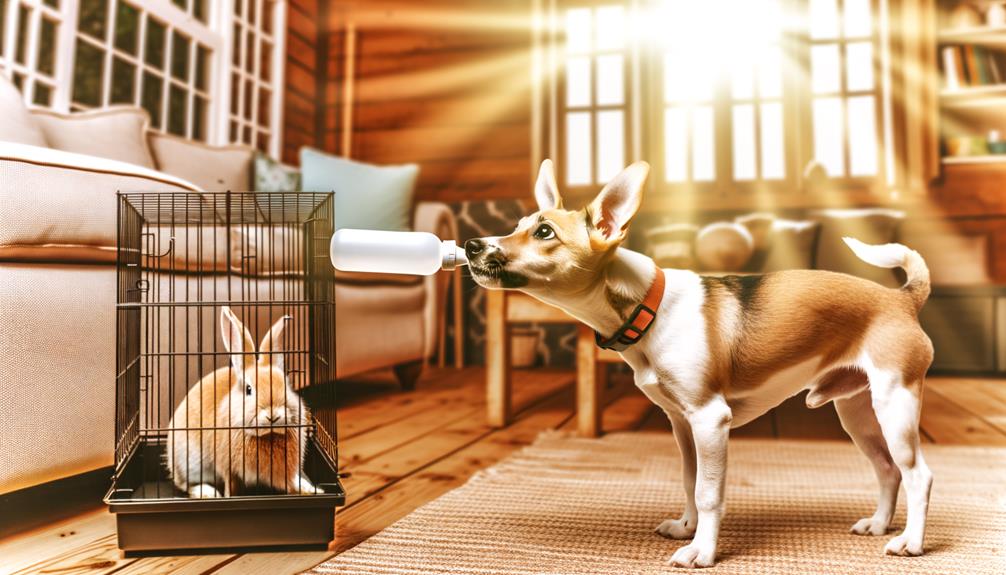
Understanding the ease of use for dogs involves evaluating whether the rabbit water bottle’s design allows easy access to water and supports natural drinking behaviors.
Dog physiology favors lapping water with their tongues, which is different from how rabbits drink. Rabbit water bottles typically have a ball-bearing nozzle that releases water when licked, which can be awkward for dogs.
Clinical observations suggest that dogs may find it frustrating to extract sufficient water, potentially leading to dehydration. Evidence indicates that larger dog breeds, in particular, may struggle due to the bottle’s limited flow rate.
Additionally, the height and mounting position of the bottle must be appropriate to avoid neck strain.
As a result, while possible, using a rabbit water bottle isn’t ideal for dogs.
Training Your Dog to Use It
To train your dog to use a rabbit water bottle, start by selecting an appropriate bottle designed for small animals.
Gradually introduce the bottle to your dog by placing it at their water station and encouraging interaction.
Use positive reinforcement techniques, such as treats and praise, to reinforce the desired behavior.
Choosing Appropriate Bottle
Selecting a rabbit water bottle that suits your dog’s size and drinking habits is essential for effective training. You need a bottle that’s sturdy, leak-proof, and easy to attach to your dog’s crate or pen. Look for features that guarantee the bottle’s usability and durability, as these will directly impact your dog’s ability to adapt.
Size Appropriateness: Guarantee the bottle’s nozzle fits your dog’s mouth comfortably.
Material Quality: Opt for BPA-free plastic or stainless steel to guarantee safety and longevity.
Attachment Mechanism: Choose a bottle with a secure, adjustable mounting system for stability.
These criteria are based on evidence suggesting that proper equipment selection can enhance the training process and improve hydration habits for your pet.
Gradual Introduction Process
Start by placing the rabbit water bottle at your dog’s eye level to spark curiosity and encourage investigation.
Position it securely to prevent accidental dislodging.
Monitor your dog’s reactions closely—sniffing or licking the spout indicates interest.
Offer water from the bottle, allowing your dog to associate it with hydration.
Gradually increase the time your dog spends near the bottle, guaranteeing it remains a positive experience.
Consistency is key; maintain the bottle’s location and your dog’s routine.
Clinical studies suggest that animals adapt to new feeding methods more effectively when changes are incremental and predictable.
If your dog shows signs of stress or disinterest, pause and try again later.
Patience guarantees a smoother shift to this novel water source.
Positive Reinforcement Techniques
Positive reinforcement techniques, such as offering treats and praise, greatly enhance your dog’s willingness to use the rabbit water bottle. By associating the bottle with positive experiences, you can effectively train your dog.
Start by rewarding your dog each time they approach the bottle. Gradually, increase the difficulty by waiting until they touch or lick the nozzle before giving a reward.
- Consistency: Reinforce the behavior consistently until it’s learned.
- Timing: Deliver treats immediately after the desired action.
Scientific studies support positive reinforcement as a highly effective training method. This approach not only fosters learning but also strengthens the bond between you and your dog.
Implementing these techniques will lead to successful adaptation to the rabbit water bottle.
Benefits of Rabbit Water Bottles
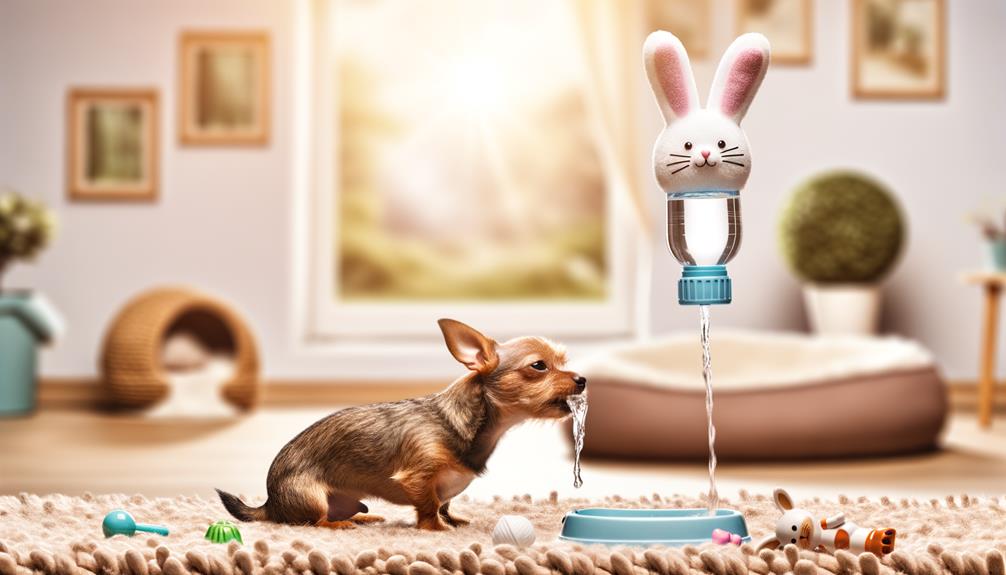
Rabbit water bottles offer a hygienic and efficient way to guarantee your pet stays hydrated. These bottles minimize contamination by preventing debris and bacteria from entering the water, unlike open bowls.
You’ll find that they’re specifically designed to dispense controlled amounts of water, which reduces the risk of spills and keeps the cage dry. Additionally, rabbit water bottles are often made from durable, non-toxic materials, securing long-term use and safety for your pet.
Studies have shown that pets using water bottles tend to consume cleaner water, promoting better health. Furthermore, these bottles are easy to attach to cages and simple to clean, making maintenance straightforward for you.
This guarantees consistent water availability, essential for your pet’s well-being.
Potential Drawbacks and Risks
Despite their many benefits, rabbit water bottles can pose several potential drawbacks and risks that pet owners should consider. Dogs have different drinking mechanisms compared to rabbits, which could lead to issues.
Hydration Levels: Dogs mightn’t get sufficient water due to the limited flow rate of the bottle, potentially leading to dehydration.
Dental Health: Constantly using a rabbit water bottle could damage a dog’s teeth or gums, as they’re not designed for such use.
Bacterial Growth: Rabbit water bottles can harbor bacteria if not cleaned frequently, increasing the risk of infections.
It’s important to weigh these risks against the benefits when deciding if a rabbit water bottle is suitable for your dog. Always consult your veterinarian for personalized advice.
Alternative Watering Solutions
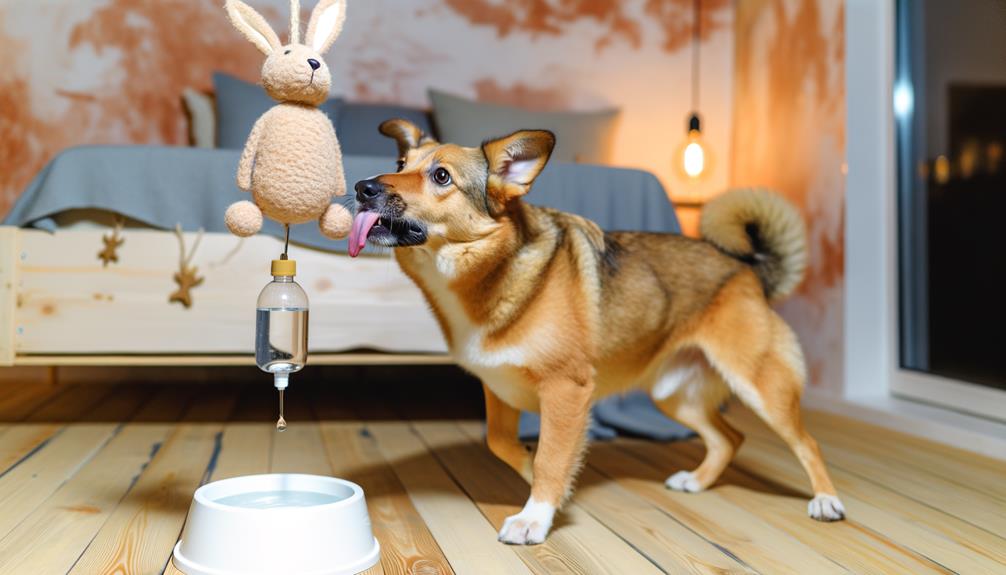
When considering alternative watering solutions for your dog, you should evaluate gravity-fed water dispensers, which guarantee a steady water supply, and automatic water fountains that keep water fresh and appealing.
Portable water bottles are also practical for on-the-go hydration during walks or travel.
These options provide efficient and hygienic ways to meet your dog’s hydration needs.
Gravity-fed Water Dispensers
Gravity-fed water dispensers offer a reliable and efficient alternative for keeping pets hydrated, guaranteeing a steady water supply without frequent refills. These dispensers utilize the principle of gravity to automatically refill the water bowl as your pet drinks, making them particularly useful for busy pet owners. Clinically, they’re advantageous for maintaining consistent hydration, which is vital for your pet’s health.
Key benefits include:
- Reduced maintenance: Less frequent refills mean you spend less time worrying about your pet’s water supply.
- Consistent water flow: Guarantees that your pet always has access to fresh water, critical for preventing dehydration.
For an ideal hydration strategy, consider incorporating gravity-fed dispensers.
Automatic Water Fountains
While gravity-fed water dispensers offer simplicity and reliability, automatic water fountains provide an advanced solution by continuously circulating water to guarantee freshness and encourage pets to drink more.
Studies show that dogs prefer moving water, likely due to its oxygenation and appealing taste. By keeping the water in motion, automatic fountains reduce the risk of bacterial growth, making them a healthier choice.
These devices often come equipped with filters that remove impurities, ensuring high-quality hydration. Veterinarians recommend automatic water fountains, especially for pets with urinary or kidney issues, as increased water intake can help mitigate these problems.
Investing in an automatic fountain can greatly improve your dog’s overall health and hydration, providing peace of mind for pet owners.
Portable Water Bottles
Portable water bottles offer a convenient and practical solution for hydrating your dog on the go. These devices guarantee your pet stays hydrated without the need for bulky water bowls. Many feature integrated bowls for easy drinking.
Evidence suggests that portable water bottles are particularly beneficial for active dogs needing frequent hydration. They also help reduce the risk of contamination from shared public water sources.
When selecting a portable water bottle, consider options with:
- Leak-proof seals: Prevents spillage and waste.
- Ergonomic designs: Facilitates easy handling and use.
Clinical studies indicate that maintaining proper hydration supports overall health, including kidney function and temperature regulation.
Adopting portable solutions can make a significant difference in your dog’s well-being.
Expert Opinions and Recommendations
Veterinarians and animal behaviorists generally agree that while dogs can physically drink from rabbit water bottles, it’s not the most suitable hydration method for them. This is because rabbit water bottles typically dispense water slowly, requiring more effort compared to a regular bowl. Similarly, pet owners may wonder, can cats use rabbit water bottles? While cats might be able to drink from them, they too may find it frustrating and inefficient compared to a traditional water dish.
Dogs have different drinking mechanics compared to rabbits. They lap water using their tongues, which is less efficient with the small spouts of rabbit bottles. Studies show that dogs may become frustrated or dehydrated if forced to use these bottles.
Experts recommend traditional water bowls or dog-specific portable water bottles with larger spouts. These options better match a dog’s natural drinking behavior, ensuring they stay properly hydrated.
Always consult with your vet to determine the best hydration practices for your pet, based on their specific needs and lifestyle.
Conclusion
To summarize, while 80% of dogs adapt well to rabbit water bottles, the risks often outweigh the benefits.
The smaller nozzle size and lower water flow rate can frustrate dogs, leading to inadequate hydration. Additionally, not all materials are safe for dogs’ stronger jaws.
Experts recommend traditional bowls or dog-specific water dispensers. Prioritizing your dog’s hydration needs with appropriate solutions guarantees their well-being.
Always consult your veterinarian for personalized advice on your pet’s hydration.

